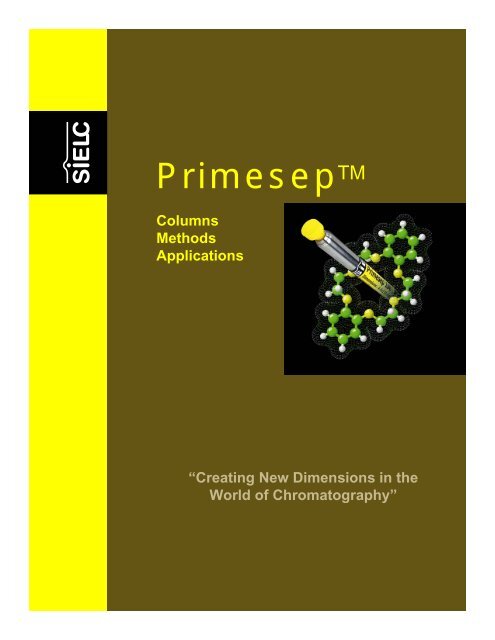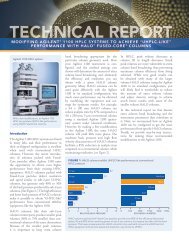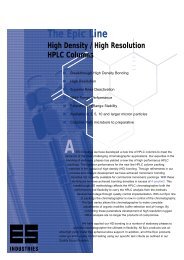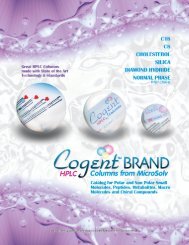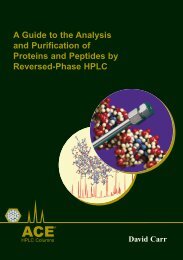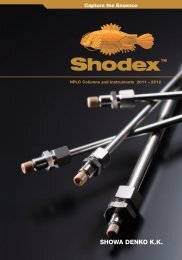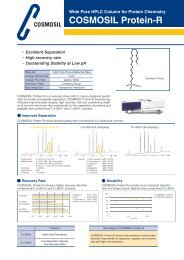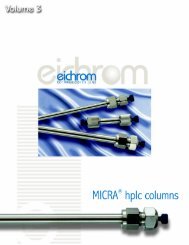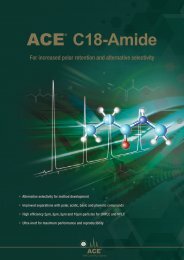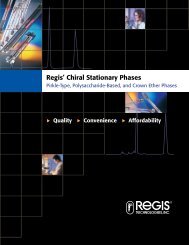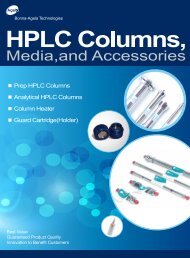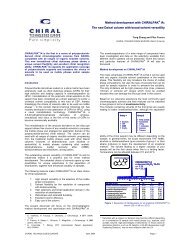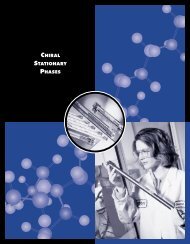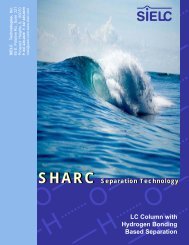Primesep Columns, Methods, Applications
Primesep Columns, Methods, Applications
Primesep Columns, Methods, Applications
You also want an ePaper? Increase the reach of your titles
YUMPU automatically turns print PDFs into web optimized ePapers that Google loves.
<strong>Primesep</strong> TM<strong>Columns</strong><strong>Methods</strong><strong>Applications</strong>“Creating New Dimensions in theWorld of Chromatography”1www.primesep.com 1
Content• Introduction• Novel stationary phase properties• Retention of polar compounds without ion-pairing reagents• Retention of polar and hydrophobic compounds by isocratic method• Universal stationary phases for reverse, normal, ion-exchange andion-exclusion chromatography• Unique adjustable selectivity• Simultaneous separation of inorganic ions and organic compounds in asingle HPLC method• Improving peak shape of strong bases and acids by ion-exclusionmechanism• ELSD, MS, and preparative chromatography compatible technology foranalysis and separation of complex mixtures• 2-D HPLC Separation with Mixed-Mode <strong>Primesep</strong> <strong>Columns</strong>• Direct plasma analysis2www.primesep.com 2
IntroductionFor decades liquid chromatography stationary phase design has been dominated by theelimination of the multiple or “unwanted” interactions that occur in mixed-mode separations. Forinstance, base-deactivated reversed-phases were developed to eliminate silanol interactions withamine-containing analytes. In size-exclusion chromatography it is assumed that only stericinteractions and not adsorption interactions are both present and desired. In ion-exchange and ionexclusionchromatography that are based on ionic interactions, nonionic interactions are generallyviewed as complications to a separation and, thus, are undesirable. However, there is a way tobenefit from multiple interactions on the stationary phase.<strong>Primesep</strong> TM HPLC columns are designed for mixed-mode separations and capable of separatinga tremendous range of compounds by different separation modes based only on the mobile phaseselection. With an embedded ion-pairing group, the columns require no ion-pairing reagents in themobile phase to retain and separate ionizable polar compounds.These columns have shown to efficiently separate organic and inorganic ions in ion-exchangeand ion-exclusion modes. The columns can be used to provide efficient separation in normal phase,reverse phase, and polar organic modes. Different modes of separation offer different columnselectivity.An organic pharmaceutical can be quantified with its inorganic counter ion on the same column atthe same time. Also, inorganic cations and anions can be run together without an ion-chromatographysystem with a resin clean-up device. Unlike with reversed-phase columns, selectivity can be alterednot only by varying organic modifier concentration, but also by changing acid modifier type andconcentration. These tools open a new realm of choices to alter selectivity and elution order ofanalytes.In most cases, separations require a simple mobile phase containing acetonitrile, water and TFAor formic acid. This simplifies the process of analytical method development and allows switchingfrom one detection technique to another without changing a separation method. All common detectiontechniques such as MS, ELSD, UV, and RI are compatible with this volatile mobile phase.The mobile phase allows simple scale up from analytical to preparative separations with nochanges in the separation conditions.The columns are resistant to dewetting in 100% aqueous mobile phase and are stable in pureorganic and highly acidic conditions down to pH 1.0.Any silanol or metal chelating interactions are completely eliminated and do not affect theefficiency of the separation.The column chemistry is reproducible from lot to lot; absolute and relative retentions of neutraland charged compounds are maintained within close tolerances.Novel Stationary Phase PropertiesIn ion-pairing chromatography, retention of ionizable species is controlled by concentration and typeof ion-pairing reagents.Pentanesulfonic acid, heptanesulfonic acid, sodium dodecylsulfate, tetrabutylammonium hydroxideare ion-pairing reagents that are typically used for retention of polar compounds in the reverse phasechromatography. By analogy, <strong>Primesep</strong> TM HPLC mixed-mode columns are offered in severalmodifications of the stationary phase with different strengths of ion-bearing groups for cation exchangemode (<strong>Primesep</strong> A, <strong>Primesep</strong> 100, <strong>Primesep</strong> 200, <strong>Primesep</strong> 300) and for anion-exchange mode(<strong>Primesep</strong> B and <strong>Primesep</strong> B2).<strong>Primesep</strong> C column forms a strong complex with amines. The strength of the complex increasesfrom tertiary to secondary, and primary amines. A pKa value for amines usually decreases in the sameorder. Contrary to ion-exchange separation, a reverse elution order is observed on <strong>Primesep</strong> Ccolumns for the substituted amines3www.primesep.com 3
Mixed-Mode <strong>Primesep</strong> <strong>Columns</strong>With an embedded ion-pairing group, a <strong>Primesep</strong> column requires no ion-pairing reagent inthe mobile phase to retain and separate ionizable polar compounds.<strong>Primesep</strong> A<strong>Primesep</strong> 100<strong>Primesep</strong> 200<strong>Primesep</strong> 300<strong>Primesep</strong> B<strong>Primesep</strong> B2ABABABA newly developed <strong>Primesep</strong> C column (C standsfor “complex”) forms a week complex with aminocompounds and metal ions. With a reverse stationaryphase as a basis for primary interaction, the columnoffers a typical RP retention profile for neutralcompounds. In addition, embedded hosting groupsinteract with amines and other ions, and form a uniqueretention pattern. Amines with equal hydrophobicityretain on <strong>Primesep</strong> C in the following order:tertiary
<strong>Primesep</strong> <strong>Columns</strong> ComparisonMaleic acidBenzonitrileBenzylamine<strong>Primesep</strong> AMaleic acidMaleic acidBenzylamine<strong>Primesep</strong> columns aredifferent in the degree they retainionic compounds.Neutral compounds areretained on all columns similarly.<strong>Primesep</strong> A, 100, 200 and 300are cation exchange columnswith different strengths ofembedded functional groups.<strong>Primesep</strong> B and B2 are anionexchange columns.<strong>Primesep</strong> is a silica basedmaterial which is stable in allorganic solvents and water at pHrange from 1.0 to 7.5BenzylamineBenzonitrileMaleic acidBenzonitrileBenzonitrileBenzylamine<strong>Primesep</strong> 100<strong>Primesep</strong> 200<strong>Primesep</strong> BBenzylamineMaleic acidBenzonitrile<strong>Primesep</strong> B20 5 10 min15Maleic acidBenzylamineBenzonitrileCommon C18<strong>Columns</strong>: 150 x 4.6 mm x 5 umFlow rate: 1.0 mL/min.Detector: UV 210 nmMobile phase:Water/MeCN/TFA-60/40/0.10 5 10 min155www.primesep.com 5
<strong>Primesep</strong> 100 Column Resists Loss of Retention in 100% AqueousMobile PhaseReverse-phase columns normally do not perform well in 100% aqueous mobile phase.Dewetting of silica pores or collapse of the alkyl chains of the stationary phase causes a sudden lossof retention in this condition.<strong>Primesep</strong> columns are designed with polar ionizable groups within a stationary phase layer,attracting enough water to keep the column in the wetted state with unfold alkyl chains. Our columnsare comparable with YMC-AQ® and Waters Polarity®, but different in selectivity and ability to work inother modes of separation besides a reverse mode, such as normal separation, polar organicseparation, ion-exchange, and ion-exclusion. These columns have no end capping chemistry.Loss-of-end capping is a common cause of changing column properties and lost selectivity.<strong>Primesep</strong> column has only one type of ligand on silica surface. Loss of this ligand is due to aging orharsh use conditions does not affect relative contribution of each separation mode.mAU8007006005004003002002.435A3.361BColumn: <strong>Primesep</strong> 100Mobile phase:A Water/MeCN – 85/15%B Water – 100%. The column was leftwith no flow at zero pressure for 24 hrSample: benzoquinone 0.1 mg/ml inwaterInjection: 5 ulDetector: UV 270 nm10001 2 3 4minmAU10008006004002001.173B2.702AColumn: Conventional C8Mobile phase: A Water/MeCN –85/15%B Water – 100%. The column wasleft with no flow at zero pressure for1 hrSample: benzoquinone 0.1 mg/ml inwaterInjection: 5 ulDetector: UV 270 nm01 2 3 4min6www.primesep.com 6
Amitriptyline TestThe amitriptyline test shows residual silanol activity. <strong>Primesep</strong> columns demonstrate zero silanolinteraction with any charged compounds. The strong cation or anion exchange groups completelymask any silanol effects.Peak symmetry 0.85Column: <strong>Primesep</strong> B 150 x 4.6 mm x5 umFlow rate: 1.0 mL/min.Mobile phase: GradientMeCN/H 2O-10/90 to 30/70 in 15 minwith 0.1 % TFAUV - 250 nm0 5 10 15minLot to Lot Reproducibility of <strong>Primesep</strong> 100Every <strong>Primesep</strong> column has a dual chemistry stationary phase with a hydrophobic long alkylchain and an ionizable cationic or anionic embedded group. When the polar group bears a charge, iteffectively shields any other less polar groups of the stationary phase. As a result, silanol groups,which cause unwanted interaction in many reverse-phase columns, are completely undetectable anddo not affect the peak shape and selectivity.<strong>Primesep</strong> multi-step manufacturing process guarantees good reproducibility of retention ofneutral, acidic and basic compounds. The plot below shows the consistency of performance achievedon 13 lots of the stationary phases synthesized from 3 different lots of silica gel during one year.Retention, minLot to Lot Reproducibility of <strong>Primesep</strong> 100 Silica121086420Lot #RSD, %Benzoic acid 1.6Benzonitrile 1.6Benzylamine 2.6Column: <strong>Primesep</strong> 100Mobile phase:Water/MeCN/TFA–50/50/0.8Sample Injection: 5 ulDetector: UV 210 nm7www.primesep.com 7
Retention of Polar Compounds without Ion-Pairing ReagentsIn many fields, and in liquid chromatography particularly, the reverse-phase mode is a technique ofchoice to solve many separation problems. One of the limitations of reverse-phase columns is lack ofretention of highly polar compounds on conventional stationary phases. Traditionally, mobile phaseadditives, such as ion-pairing reagents, have to be employed to achieve the separation of thesecompounds. In its turn, the use of ion-paring reagents also has its limitations, i.e. artifacts when usinggradient elution, incompatibility with Mass Spectrometry, Evaporating Light Scattering Detection,preparative chromatography, and more complex mobile phase preparations.None of these limitations exist for <strong>Primesep</strong> mixed-mode stationary phases that are suitable forseparations of polar and non-polar compounds at both analytical and preparative scales in isocratic andgradient modes. These stationary phases allow for a great degree of flexibility in the separation of abroad range of analytes on one stationary phase platform using simple mobile phases that arecompatible with multiple detection modes.Dopamine SeparationUSP L1 type column,300 x 4.6 mmMobile Phase:MeCN/H 2O with 1% AcOHand 0.1% OctanesulfonicAcid – 15/85Flow rate: 1.5 mL/minDetector: UV 280Dopamine<strong>Primesep</strong> 200, 50 x 4.6 mmMobile Phase:H 2O/MeCN/TFA - 90/10/0.02Flow rate: 1.0 mL/minDetector: UV 210Tyrosinedl-DOPADopamineEpinephrine0 2 4 6 8 10 12 14 minEthanolamines SeparationPolar compounds areseparated on <strong>Primesep</strong>columns by degree of polarinteraction. Polar interactionincludes electrostaticinteraction which can beutilized by ion-exchangemechanism or hydrogenbonding which are adjustableby amount of water in themobile phase.<strong>Primesep</strong> 100, 150 x 4.6 mmMobile Phase:H 2O/MeCN/TFA - 95/5/0.1Flow rate: 1.0 mL/minDetector:ELSD0 2.5 5 7.5MonoethanolamineDiethanolamineminTriethanolamine05 10min8www.primesep.com 8
Analysis of Amino SugarsRH 2 NOHOR'HO OHColumn: <strong>Primesep</strong> 100150 x 4.6 mm x 5 umFlow rate: 1.5 mL/min.Mobile phase:Water/MeCN/H 2 SO 4 –8/92/0.03pH= 2.1Temperature: 40 o CDetection: UV - 205 nm10 20 30 40minExample of Method DevelopmentColumn: <strong>Primesep</strong> 100150 x 4.6 mm x 5 umFlow rate: 1.5 mL/min.Temperature: 40 o CDetection: UV - 205 nmDifferent compounds respond differently to changes inconcentration of organic modifier. Neutral non-polarcompounds are effected significantly, while polar compoundsshow a different response. This is a powerful tool for separationtuning on <strong>Primesep</strong> columns.Water/MeCN/H 2 SO 4 –92/8/0.035 10 15 20 25 30 35 40minWater/MeCN/H 2 SO 4 –90/10/0.035 10 15 20 25 30 35 40minWater/MeCN/H 2 SO 4 –87/13/0.035 10 15 20 25 30 35 40minWater/MeCN/H 2 SO 4 –84/16/0.035 10 15 20 25 30 35 40min9www.primesep.com 9
Separation of NucleobasesIt’s a known fact that polar organic compounds retain poorly on reverse-phase columns. Thesecompounds often have an ionizable group in a molecule whose bearing charge makes the molecule evenmore polar and difficult to retain and separate. The <strong>Primesep</strong> 200 column is a unique solution for thissituation.<strong>Primesep</strong> 2002323Common C81451.Uracil2.Thymine3.Cytosine4.Guanine5.Adenine145Column Size:250 x 4.6 mm x 5 umInjection: 5 mclDetection: UV 270 nmMobile phase:Water/MeCN/TFA –90/10/0.2 %0 2 4 6 8min0 2 4 6 8minSeparation of NucleosidesColumn:<strong>Primesep</strong> 200Size: 250 x 4.6 mmDetector: UV 270 nmMobile phase:Water/MeCN/TFA –85/15/0.075 %12 31. Deoxyuridine2. Deoxyguanosine3. Deoxycytidine4. Deoxyadenozine41234Column: Common C18Size: 250 x 4.6 mmDetector: UV 270 nmMobile phase:Water/MeCN/TFA –90/10/0.1 %0 5min0 5minIon-Exchange Mechanism in High Organic Mobile Phase.Analysis of Glyphosate.1<strong>Primesep</strong> B2<strong>Primesep</strong> 10021Column 50 x 4.6 mmMobile phase:Water/MeCN/TFA–70/30/0.1Flow rate: 0.5 ml/minDetection: ELSD02 4min02 4min1. Isopropyl amine2. Glyphosate10www.primesep.com 10
Analysis of Amino AcidsThe presence of ion-exchange groups on a <strong>Primesep</strong> column makes it a perfect choice for separationof underivatized amino acids.Acid gradient allows separation of compounds with significantly different pKa within a singlechromatography run.<strong>Primesep</strong> 100 250 x 4.6 mmMobile phase: MeCN/H 2 O–30/70TFA gradient 0.05 to 0.3% in 25 minFlow rate: 1.0 ml/minSample: 0.1 mg/ml in waterDetector: ELSDGLU ALA VALASPMETCYSPHEILEHISLYSARG0 5 10 15 20minExtremely Fast Equilibration Time with Acid GradientThe presence of the acidic groups on the <strong>Primesep</strong> column prevents retention of anacid on the stationary phase. It results in quick equilibration time equal to 2-3 columnvolumes. Thus, an acid gradient is a convenient option for separation of compounds with adrastically different pKa value.TFA, %0.25 UV0.20Norm.1000800Gradient wasstopped at 15min<strong>Primesep</strong> 100 150 x 4.6 mmMobile phase: MeCN/H 2O–15/85TFA gradient 0.05 to 0.25% in 15 minFlow rate: 1.0 ml/minDetector: UV 210 nm0.15010600400Base lineis fullyrestoredat 19 min0.05200000 5 10 15 20min11www.primesep.com 11
Retention of Polar CompoundsComplex mixtures with very polarand very hydrophobic compounds canbe resolved with a gradient method.Column: <strong>Primesep</strong> 100150 x 4.6 mm x 5 umFlow rate: 1.0 mL/min.Mobile phase:Water/MeCN/H 2 SO 4 -85/15/0.06 to55/45/0.06 in 20 min + 5 min hold.Detector: UV: 210 nmL - Cysteine2 - MethylcysteineBenzoic AcidL - Cystine2, 2’-DimethylcystineToluene0 5 10 15 20minIn similar conditions commonreverse phase columns gave noretention of polar compounds andwould require an ion-pairing reagent inthe mobile phase.Column: Common C8150 x 4.6 mm x 5 umFlow rate: 1.0 mL/min.Mobile phase:Water/MeCN/H 2 SO 4 -100/0/0.06 to 40/60/0.06 in 25 min.Detector: UV 210 nmL-Cysteine2-MethylcysteineL-Cystine2,2’-DimethylcystineBenzoic acidToluene0 5 10 15 20 25minQuaternary amines are strong basses.They are not volatile and can not beanalyzed by GC. A typical HPLCseparation will result in no or very littleretention for these polar molecules.<strong>Primesep</strong> C column with volatile mobilephase allows to separate and quantitatequaternary amines with an ELSD or MSdetection technique.<strong>Primesep</strong> C 50 x 4.6 mm x 5 umMobile phase: MeCN/H 2O–15/85TEA acetate 20 mM pH 5.0Flow rate: 1.0 ml/minSample: 0.6 mg/ml eachInjection: 5 mcDetector: ELSD, (Temperature 35 o C)Separation of Quaternary AminesTetramethylammoniumMethyltriethylammoniumTetraethylammonium02.5 5 7.5min12www.primesep.com 12
Ion-Exchange and Hydrophobic Mechanism in Separation of TertiaryAmines.Strong basses, such as tertiary amines, retain toostrongly on <strong>Primesep</strong> A or <strong>Primesep</strong> 100 columns. <strong>Primesep</strong>200 is a weaker cation exchanger than <strong>Primesep</strong> 100 and<strong>Primesep</strong> A, and it separates strong basses in mildconditions.<strong>Primesep</strong> 200 column 150 x 4.6 mm x 5 umMobile phase: MeCN/H 2O/TFA–20/80/0.15Flow rate: 1.0 ml/minInjection: 5 ulSample: 3.0 mg/ml eachDetector: ELSD, (Temperature 35 o C)TrimethylamineTriethylamineDiisopropylethylamineN,N-Dimethylbenzylamine05minIon-Exchange and Hydrophobic Mechanism in Separation of Amines.<strong>Primesep</strong> A column 150 x 4.6 mmDetection: ELSD, (Temperature 35 o C)Mobile phase: MeCN/H 2O–15/85TFA gradient 0.05 to 0.25% in 15 minFlow rate: 1.0 ml/minSample: 1.0 mg/ml eachMethylamineAmmoniaMorpholineEthylamineDiethylamineButylamine0 2.5 5 7.5 10 12.5min13www.primesep.com 13
Retention of polar and hydrophobic compounds by isocraticmethod<strong>Primesep</strong> mixed-mode stationary phases provide multiple types of interactions with analytes.Ionizable compounds interact with the stationary phase by reverse-phase, ion-exchange or ionexclusionmechanisms. The amount of the acid in the mobile phase influences the retention attributedto the ion-exchange interaction to the same degree as the organic modifier affects the retention inreverse-phase separation. Thus, the amounts of organic and acidic modifiers are both important forcontrol of retention of ionizable analytes.Separation of Active Ingredients in Cough and Cold DrugsMaleateBromateAcetaminophenPseudoephedrineColumn: <strong>Primesep</strong> C 150 x 4.6 mmFlow rate: 1.0 mL/min.UV: 205 nmInjection: 5 ulMobile phase: TEA 50 mM PhosphatepH 3.0/MeCN - 40/60DoxylamineDextromethorphan012345678910Maleate BromatePseudoephedrineAcetaminophenDoxylamineColumn: Leading brand C18150 x 4.6 mmFlow rate: 1.0 mL/min.UV: 205 nmInjection: 5 ulMobile phase: TEA 25 mMPhosphate pH 3.0 /MeCN - 80/20Dextromethorphan0 2.5 5 7.5 10 12.5 15 17.5min14www.primesep.com 14
Ion-Exchange and Hydrophobic Mechanism In Separation ofNeurotransmitters.NorepinephrineEpinephrineDOPADopamineTyrosinePhenylalanineCatecholaminesPathwaySeparation ofCatecholaminesPhenylalanineTyrosineDOPADopamineNorepinephrineEpinephrine<strong>Primesep</strong> 200, 150 x 3.2 mmMobile Phase:H 2O/MeCN/TFA - 90/10/0.1Flow rate: 0.5 mL/minDetector: UV 210 nm0 5 10minProcainomideBoth a cationic drug and chloride anion areanalyzed with single isocratic methodColumn: <strong>Primesep</strong> B 150 x 4.6 mm x 5 umFlow rate: 1.0 mL/min.Mobile phase: Water/MeCN/AmAc–40/60/0.2Detector: ELSD , UV 210 nmCl -01.02.03.04.05.06.0min15www.primesep.com 15
Unique Adjustable Selectivity<strong>Primesep</strong> mixed-mode stationary phases provide multiple types of interactions with analytes.Ionizable compounds interact with the stationary phase by reverse-phase, ion-exchange or ionexclusionmechanisms. The amount of the acid in the mobile phase influences the retention attributedto the ion-exchange interaction to the same degree as the organic modifier affects the retention inreverse-phase separation. Thus, the amounts of organic and acidic modifiers are both important forcontrol of retention of ionizable analytes.In addition to hydrophobic interactions, neutral compounds participate in different polar interactionswith highly polar column functional groups. The behavior of polar groups can be modified by varying themobile phase.Basic functional groups on <strong>Primesep</strong> B column form salts with different acid residue (sulfate,perchlorate, trifluoroacetate, etc.), and each salt participates differently in polar interaction with neutralanalytes. Analytes themselves can be ionized in many ways depending on the pH of the mobile phase,and retention time of your compounds can also be substantially altered by changing the pH of themobile phase.Effect of Acidic Modifier on SelectivityMeCN/H2O 60/40HCOOH 0.9%ROEt0 10 20 30MeCN/H 2 O 60/40TFA 0.02%minRR0 10 20 30MeCN/H 2 O 60/40H 3PO 40.16%minOEtOEt0 10 20 30MeCN/H 2 O 60/40HClO 40.03%minROEt0 10 20 30MeCN/H 2 O 55/45HCOOH 0.5%min<strong>Primesep</strong> B (blue)150 x 4.6 mm x 5 umCommon C18 (red)250 x 4.6 x 5 um0 10 20 30minFlow rate: 1.0 mL/min.UV - 250 nm16www.primesep.com 16
Control of Retention and ResolutionCritical pairs wereresolved in this mixture bychanging ion-exchangemechanism in mixed-modeinteraction132457, 6Mobile phase:Water/MeCN/TFA–70/30/0.281. Mandelic acid2. Tyrosine3. Benzoic acid4. Pyridine5. Phenylalanine6. Benzylamine7. Benzonitrile8. Toluene0 5 10 15 20 2513782Mobile phase:Water/MeCN/TFA–30/70/0.15564min<strong>Primesep</strong> 100150 x 4.6 mm x 10 umFlow rate: 1.0 mL/min.Detector UV - 210 nm0 2 4 6 8minRetention time, min50403020100Mandelic acidBenzoic AcidTyrosinePhenylalanineBenzonitrileBenzylaminePyridineToluene10 20 30 40 50 60 70Water, %Effect of WaterConcentration<strong>Primesep</strong> 100 column150 x 4.6 mm x 10 umFlow rate: 1.0 mL/min.Mobile phase:Water/MeCN withTFA-0.05%Detector: UV - 210 nmRetention time, min5040302010Mandelic acidBenzoic AcidTyrosinePhenylalanineBenzonitrileBenzylaminePyridineTolueneEffect of TFAConcentration<strong>Primesep</strong> 100 column150 x 4.6 mm x 10 umFlow rate: 1.0 mL/min.Mobile phase:Water/MeCN – 70/30Detector: UV - 210 nm00.05 0.10 0.15 0.20TFA, %17www.primesep.com 17
Control of Elution OrderHOOMeCN/Water/TFA -70/30/0.3MeCN/Water/HCOOH -70/30/0.3HOONColumn: <strong>Primesep</strong> B150 x 3.2 mmFlow rate: 0.5 mL/min.Detector: UV - 250 nmN0 5 10min0 10 20minHOOMeCN/Water/TFA- 70/30/0.3HOOMeCN/Water/HCOOH -70/30/0.3NColumn: C18 brand150 x 3.2 mmFlow rate: 0.5 mL/min.Detector: UV - 250 nmN0 2.5 5 7.5min0 2.5 5 7.5min<strong>Primesep</strong> B has an embedded anion exchange functional group, allowing a reversal retention order byusing HCOOH instead of TFA in the mobile phase. Separation on typical reverse phase columns arenot effected by type of acidic modifier.<strong>Primesep</strong> 100Hexane/Ethanol –98/2 - 80/20 - 30 min<strong>Primesep</strong> 100Water/MeCN –20/80-100/0 - 25 minKromasil KR100-7Hexane/Ethanol –98/2 - 80/20 - 30 min3322110 5 10 15 20112 332NormalModeReverseModeNormalModeminSeparation of Steroids.Reversed vs. Normal ModeNeutral steroids are resolved in reverse andnormal mode. The separation pattern vary indifferent separations modes and allows toselect appropriate condition for a specificdetection technique or a preparativeseparation. Also, a single column allows tohave two alternative separation techniques toisolate impurity that may co-elute in a differentseparation mode.<strong>Primesep</strong> 100 offers functional groups forinteraction with the analyte that are differentfrom silanol groups which are responsible fornormal phase interaction on bare silica.Column: 250 x 4.6 mmFlow rate: 1.0 mL/min. UV - 240 nm20www.primesep.com 20
Universal Stationary Phase for Reverse, Normal, Ion-Exchange, and Ion-Exclusion Chromatography<strong>Primesep</strong> TM mixed-mode stationary phases provide two functional groups for interaction withanalytes. One is a very hydrophobic alkyl chain, another is a very hydrophilic acid residue (<strong>Primesep</strong> A,100, 200), or a protonated base (<strong>Primesep</strong> B).With two functional groups of such difference in polarity, multiple separation modes can be performedon a single column.Neutral compounds can be resolved in reverse, normal, or polar organic mode. Charged moleculescan be resolved in reverse, normal, polar organic, ion-exchange, or ion-exclusion modes. Also, thecombination of more than one mode is typical for ionizable molecules.Selection of the mode of separation is governed by the type of the mobile phase selected for theparticular separation.Reverse - Phase Separation563, 421<strong>Primesep</strong> 100 column150 x 4.6 mm x 5 umFlow rate: 1.0 mL/min. UV -250 nmWater/MeCN/TFA–40/60/0.2-20/80/0.2-12 min0 2 4 6 8Normal - Phase Separation1. Benzoin2. Deoxybenzoin3. Benzil4. 4-Methyldeoxybenzoin5. Benzylbenzoate6. Bibenzyl123 45min<strong>Primesep</strong> 100 column150 x 4.6 mm x 5 umFlow rate: 1.0 mL/min. UV -220 nmHexane/TBA–99.5/0.5 - 95/5in 10 min602 4 6 8 10 12minOOOOHOOOO12 3 4 5 6Me21www.primesep.com 21
Ion-Exchange Mode. Separation of Inorganic Cations<strong>Primesep</strong> 100 column 250 x 4.6 mm x 5umFlow rate: 0.5 mL/min. ELSD.Mobile Phase: H O/MeCN/TFA –30/70/0.2Li + Na + K + 2Mg ++ Ca ++ Zn ++05 10 15 20minIon-Exclusion Mechanism. Separation of Diacids.<strong>Primesep</strong> 100 column 150 x 4.6 mm x 5 umMobile phase: Water/MeCN/H 2 SO 4 –75/25/0.03Detection: UV 210 nm4Flow 0.3 ml/minFlow: 1.0 ml/min14212pKa1. Maleic acid 1.832. Malic acid 3.403. Succinic acid 4.164. Fumaric acid 3.03330 2 4 6 8min22www.primesep.com 22
When a complex mixture is analyzed using <strong>Primesep</strong> columns, two or more interaction mechanismshelp to tune the separation. Elution order and retention time can be adjusted in accordance with youranalytical needs. The typical combinations of the mechanisms are: reverse phase – ion-exchange;reverse phase – ion exclusion; hydrophilic interaction – ion-exchange; chelating - reverse phase.Ion-Exclusion and Reverse Phase Mechanism in Separation of Diacids.Column: <strong>Primesep</strong> 200 250 x 4.6mm x 5 umMobile phase: MeCN/Water/TFA –15/85/0.1Flow rate: 0.5 mL/min Detector: UV210 nmInjection: 5 uL of solution of malic andsuccinic acids (5 mg/mL); fumaric, andmaleic acids (0.2 mg/mL) in waterMalic acidSuccinic acidFumaric acidMaleic acid0 2 4 6 8 10minIon-Exchange and Reverse Phase Mechanism in Separation of Acids.21. Fumaric acid2. Benzoic acid3. Phthalic acid4. Naphthoic acid5. Maleic acid3<strong>Primesep</strong> B column 150 x 4.6 mm x 5 umDetection: UV 250 nmMobile Phase: MeCN/Water/ TFA –30/70/0.081540 5 10 1523<strong>Primesep</strong> B column 150 x 4.6 mm x 5 umDetection: UV 250 nmMobile Phase: MeCN/water/ TFA –60/40/0/08min4150 5 10 15min23www.primesep.com 23
Simultaneous Separation of Inorganic Ions and OrganicCompounds in Single HPLC MethodIn many instances, ionizable compounds exist as salts of organic molecules with inorganic counterions. This is common for drugs, surface active compounds, biological molecules, and many otherindustrial and research substances. Typically, two independent analytical methods are created foranalysis of such salts – reverse phase for organic part and ion chromatography method, or titration, forinorganic part.<strong>Primesep</strong> TM columns offer a unique ability to analyze both parts of such salts at the same time.ELSD in combination with standard UV detector is a convenient tool for this purpose.Inorganics in Drug<strong>Primesep</strong> 100 column 250 x 4.6 mm x 10 umFlow rate: 1.0 mL/min.Mobile phase: Water/MeCN/TFA–50/50/0.2Injection: 5 uLNaZnFinal ProductELSDUV - 210 nm0 2.5 5 7.5 10 12.5 15 17.5minQuantitation of inorganic components of the mixture can be performed using an ELSD signal. Thisdetector is inherently not linear, but if the concentration of inorganic ion is significant, which is usuallythe case in pharmaceuticals, then significant linear region can be exploited with ELSD technology.At low concentration, a non-linear treatment of calibration curve should be used to get accurateresults.Area1.80E+021.60E+021.40E+021.20E+021.00E+028.00E+016.00E+014.00E+012.00E+010.00E+00-2.00E+01R 2 = 0.99770 0.5 1 1.5 2 2.5Concentration, mg/mlArea5.004.003.002.001.000.000 0.1 0.2Concentration, mg/ml24www.primesep.com 24
K +Quantitation of PotassiumStarting material<strong>Primesep</strong> 100 column250 x 4.6 mm x 5 umFlow rate: 1.0 mL/min.Mobile phase:Water/MeCN/TFA–40/60/0.2ProductELSDUV - 245 nm05 10 15 20minCompound AAnalysis of Nickel in Hydrogenation ReactionDetector:ELSDDetector:UV - 245 nm<strong>Primesep</strong> 100 column150 x 4.6 mm x 5 umFlow rate: 1.0 mL/min.Temperature 45 o CMobile phase:Water/MeCN/TFA–60/40/0.1Compound ANi ++Product BProduct BAH 2[Ni]B0 10min0 10minAnalysis of GuanidineNa +GuanidineColumn: <strong>Primesep</strong> 100 50 x 4.6 mm 5 umMobile phase: MeCN/H 2 O/TFA – 25/75/0.05Flow rate: 1.0 ml/minDetector: ELSD , UV 200 nm0 2 4min25www.primesep.com 25
Improving Peak Shape of Strong Bases by Ion-ExclusionMechanismStrong bases like quaternary amines do not perform well chromatographically due to the strong silanolinteraction even with the best deactivated silica based columns. A strong ionic mobile phase is oftenemployed to improve the peak shape and the separation efficiency. Another approach can be used withmix-mode stationary phases. <strong>Primesep</strong> B column with a positively charged surface completely eliminatesany ion-exchange interaction of the stationary phase with positively charged analytes and, thus, offersefficient separation and a symmetrical peak shape. Retention is still controllable by varying the amount oforganic modifier in the mobile phase that provides separation of the compounds according to theirhydrophobic properties. Hydrophobic interaction is reduced due to the repulsion effect of the ion-exclusionprocess.<strong>Primesep</strong> B, 150 x 4.6 mmCase Study for Cetylpyridinium IonsFlow rate: 1.0 mL/minDetector: UV 250 nmN (CH 2 ) 14 CH 3ClLeading brand C18 column150 x 4.6 mm x 5 umMobile Phase:H 2 O/MeCN/TFA - 30/70/0.1Flow rate: 1.0 mL/minDetector: UV 250 nmPeak plate count 1640Peak symmetry 0.19Mobile Phases:MeCN/water/TFA – 55/45/0.1MeCN/water/TFA – 55/45/0.2MeCN/water/TFA – 50/50/0.1MeCN/water/TFA – 50/50/0.2MeCN/water/TFA – 45/55/0.1MeCN/water/TFA – 45/55/0.20 5 10minTetrabutylammonium hydroxide0 2.5 5 7.5 10 12.5minLeading brand C18 column150 x 4.6 mm x 3.5 umMobile Phase:H 2 O/MeCN/TFA - 70/30/0.1Flow rate: 1.0 mL/minDetector: ELSDPeak plate count 640Peak symmetry 0.37BuBuNBuBu<strong>Primesep</strong> B, 150 x 4.6 mmMobile Phase:H 2 O/MeCN/TFA - 70/30/0.15Flow rate: 1.0 mL/minDetector: ELSDPeak plate count 5200Peak symmetry 0.7005 10min0 5 10min26www.primesep.com 26
ELSD, MS, and Preparative Chromatography CompatibleTechnology for Analysis and Separation of Complex MixturesIon-pairing reagents are not compatible with preparative chromatography, LC-MS, and ELSdetection. <strong>Primesep</strong> columns offer an alternative way of retention of polar compounds through ionexchangemechanism with embedded ion-bearing groups.Load Study of HCl Saltof Polar CompoundThe amounts of ion-bearing groups on <strong>Primesep</strong> columnsare comparable to the amount of ion-bearing groups on regularion-exchange columns. A <strong>Primesep</strong> column offers a highcapacity ion-exchange mechanism. In many instances, RPcolumns designed for retention of polar compounds do not offerenough capacity when a sample has a high ion-strength. It isspecially important for the preparative chromatography. Theloading of the sample on the column is one of the mostimportant characteristics of the stationary phase when used inscale up separations.30 mg21 mg15 mg12 mg9 mg3 mg0.06 mgColumn: <strong>Primesep</strong> 1004.6x250 mm 10 umFlow rate: 1ml/minMobile phase: 50/50/0.3-MeCN/H 2 O/TFADetection: UV 230 nm0510152025min15 mg10 mg6 mg4 mg2 mgColumn: AQ type column4.6x250 mm 10 umFlow rate: 1ml/minMobile phase: 3/97/0.1MeCN/H 2 O/TFA for 12 min,then gradient to 50/50/0.1Detection: 230 nmAnalytical injectionPreparative injections510The combination of ion-exchange and reverse separation modes in a single column offers wideselection of conditions to tailor your separation in the way that is most convenient and economical. Thelast is very important when the preparative separation is required. If ionizable compounds are separated,a chromatographer can choose the conditions where a high concentration of an organic modifier ispresent in the mobile phase. Thus, the cost of solvent removal can be significantly reduced, and theorganic solvent can be recycled. Another benefit of using <strong>Primesep</strong> preparative columns is an ability toreverse the elution order of differently charged components of the mixture that helps isolate a particularcomponent in the mixture.1520min27www.primesep.com 27
302-D HPLC Separation with Mixed-Mode <strong>Primesep</strong> <strong>Columns</strong>A multidimensional technique involving coupled columns is more powerful compared to its one-dimensionalcounterpart, provided the retention mechanisms in the two dimensions are orthogonal. Mixed mode columnsoffer unique selectivity and hence are ideal formulti-dimensional separation. The stationary phase consisting ofembedded ion-pairing reagent (acidic or basic) and hydrophobic functional group offers mixed mode retentionfor the charged species. The retention of charged species is effected by the concentration of organic contentand ionogenic modifier level in the mobile phase.With this technique, the primary column effluent is sampled alternatively into dual secondary column using anelectronically controlled valve for further separation. Since columns differ in their electivity, chemicalcomponents co-eluting on the primary column are likely to resolve in the secondary column. The primarycolumn separation is comparable with a conventional HPLC whereas the secondary column separation isfaster. The high-speed separation in the secondary column enables a partial or complete transfer of primarycolumn effluent to the secondary column, which results in comprehensive two-dimensional liquid separations.Each chemical component has a uniquepair of retention times enabling positiveidentification and its location in the twodimensionalplane as a measure of itsphysical property. The key to asuccessful orthogonal separation is theright column selection. By choosing<strong>Primesep</strong> B and <strong>Primesep</strong> 100 columnswith oppositely charged embeddedfunctional groups the significantdifference in selectivity is obtained ineach dimension. The two-Dchromatographic map separates differentclasses of compounds in the planarspace, helping to identify compounds ina complex mixture.PUMP 22-D Mappingof a Mixture of Acids, Bases,and Neutral CompoundsDETECTOR1SC1L0PUMP 1INJECTORL1PCWASTEDETECTOR2Primary column <strong>Primesep</strong> B, 150 x 4.6 mm 5 um; flow rate 0.5 mL/minSecondary column <strong>Primesep</strong> 100, 20 x 4.6 mm 5 um; flow rate 2.5 mL/minDetection UV 215 nmSampling – approximately 20 percent of primary column eluentL2SC2Valve alternatebetween two positionsevery 30 secPUMP 2DETECTOR1SC1L0PUMP 1INJECTORL1PCWASTEDETECTOR2L2SC2PC - primary columnSC – secondary columnsL – intermediate loopsSecondary column retention, sec2520151010 7 12 17 22 27Courtesy of C.J. VenkatramanyPrimary column retention, min28www.primesep.com 28
Direct Plasma AnalysismAU200175PlasmacomponentsAnalysis of plasma and other biological fluids byHPLC usually requires several steps of samplepreparation. Such tasks as solid-phase extraction,liquid-liquid extraction, centrifugation, and filtrationusually are necessary steps prior to actual HPLCanalysis in order to remove proteins and peptides fromplasma to protect HPLC column. When plasma isanalyzed directly, the efficiency of the columndegrades quickly due to irreversible adsorption ofsome components of the plasma. Multi-step processincreases the cost and compromises accuracy ofdetermination.SIELC Technologies now offers a simple solutionwhich allows to analyze a broad range of smallmolecules in plasma or other biofluids via a singlecolumnsystem without any sample preparation orcommon mobile phase.This approach is based on unique stationary phaseof <strong>Primesep</strong> D column that is comprised of two typesof functional groups -- an anion exchange group andlong alkyl chain -- chemically bonded to silica support.150125100CaffeineNicotinic acid7550250.5 1 1.5 2 2.5Column: <strong>Primesep</strong> DDimensions: 50 x 4.6 mm x 5 umFlow rate: 1.0 mL/minMobile phase: MeCN/H 2 O/HCOOH-33/67/0.2Detection: UV - 250 nmSample: Caffeine and nicotinic acid0.2 mg/mL each dissolved in plasma EDTAdiluted with H2O 1:1Injection #200: 5 uLminThis combination of very polar positively-chargedgroup and very hydrophobic alkyl group in a singleligand on a surface of the stationary support allowsdirect injection of plasma and other biofluids. At pHaround 3.0, which can be obtained by adding of formicacid to the mobile phase of MeCN-H2O, most proteinsbecame positively charged and are excluded frominteraction with the surface of the stationary phase.Small negatively charged molecules can be separatedand retain on <strong>Primesep</strong> D column by anion-exchangemode or reverse phase mode chromatography. Smallhydrophobic molecules are retained and can beseparated by regular RP mode on <strong>Primesep</strong> Dcolumn.<strong>Primesep</strong> D column demonstrates high analyterecovery and high selectivity. Proteins and peptideselute as a sharp peak in void or pre-void time and theyare not interfered with analytes peaks. Simple bypassvalve can be used to remove protein peak from reachingthe detector by diverting flow to waste in first 40 seconds(for 50 mm long column -- time may need to beincreased if longer columns are used).29www.primesep.com 29
formerly Allsep TechnologiesFor decades liquid chromatography stationary phase design has been dominated bythe goal to eliminate multiple, or “unwanted”, interactions and to obtain a simple andpredictable retention mechanism. Unfortunately, the simplification of the retentionprocess limits the ability to control elution order of the analytes and the scope ofavailable applications this system can be used for. As a response to this limitation,hundreds of different reverse-phase columns were introduced in the last years tocover a variety of analytical situations.In contrast, <strong>Primesep</strong>TM stationary phases were intentionally designed with twomajor interactions offered on the same column. Both interactions are independentlyadjustable with mobile-phase composition producing unlimited states of the stationaryphase. The hydrophobic interaction is controlled by the amount of organic modifier inthe mobile phase (as in any reverse-phase column), while the ion-exchangeinteraction is controlled by the ion-strength and pH of the mobile phase (as in otherion-exchange columns). This unique property allows using one stationary phase fornumerous applications, including analyses of polar and non-polar, ionizable andneutral, organic and inorganic compounds. The behavior of <strong>Primesep</strong>TM columns ispredictable and reproducible. The method development process is simple andversatile.Create a column part number by using chart belowType of packing<strong>Primesep</strong> A<strong>Primesep</strong> B<strong>Primesep</strong> B2<strong>Primesep</strong> C<strong>Primesep</strong> P<strong>Primesep</strong> 100<strong>Primesep</strong> 200<strong>Primesep</strong> 300ABB2CP100200300A - 46 . 150 . 0510Column idColumn length22 mm 2204.6 mm46 250 mm 250Packing size Pores size3.2 mm2.1 mm3221150 mm100 mm1501005 mc m10 mc m0510100 A200 A10201.0 mm 10 50 mm 050 20 mc m 20 300 A 3030SIELC Inc. 15. East Palatine Road, Suite 107, Prospect Heights, Illinois 60070 USATel: (847) 229-2629 Fax: (847) 655-6079 Email: mail@Sielc.comCopyright © SIELC, Inc. 2001-2004www.primesep.com 30


